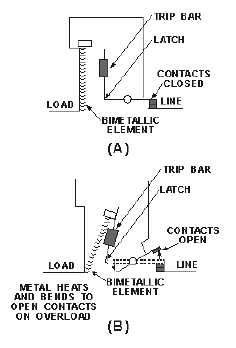2-23
magnetic trip units used by most circuit breakers. (Some circuit breakers make use of solid-state trip units
using current transformers and solid-state circuitry.)
THERMAL TRIP ELEMENT
A thermal trip element circuit breaker uses a bimetallic element that is heated by the load current.
The bimetallic element is made from strips of two different metals bonded together. The metals expand at
different rates as they are heated. This causes the bimetallic element to bend as it is heated by the current
going to the load. Figure 2-19 shows how this can be used to trip the circuit breaker.
Figure 2-19.—Thermal trip element action: A. Trip element with normal current; B. Contacts open.
Figure 2-19, view A, shows the trip element with normal current. The bimetallic element is not
heated excessively and does not bend. If the current increases (or the temperature around the circuit
breaker increases), the bimetallic element bends, pushes against the trip bar, and releases the latch. Then,
the contacts open, as shown in figure 2-19, view B.
The amount of time it takes for the bimetallic element to bend and trip the circuit breaker depends on
the amount the element is heated. A large overload will heat the element quickly. A small overload will
require a longer time to trip the circuit breaker.
MAGNETIC TRIP ELEMENT
A magnetic trip element circuit breaker uses an electromagnet in series with the circuit load as in
figure 2-20. With normal current, the electromagnet will not have enough attraction to the trip bar to
move it, and the contacts will remain closed as shown in figure 2-20, view A. The strength of the
magnetic field of the electromagnet increases as current through the coil increases. As soon as the current
in the circuit becomes large enough, the trip bar is pulled toward the magnetic element (electromagnet),
the contacts are opened, and the current stops, as shown in figure 2-20, view B.



